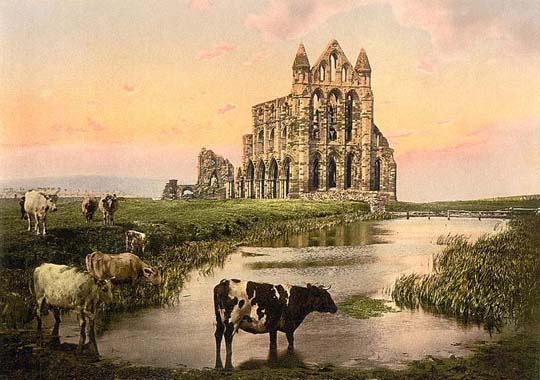
Haydock Place
Endeavour Cottage in Whitby located in the courtyard of Haydock Place.
Hilda died in 680, and was interred in the Monastery. She was succeeded in its government by her royal pupil Elfleda, then twenty-six years of age, who died and was buried in the Monastery in 713.
The history of the Abbey from the death of Elfleda to the Danish irruption, previously mentioned, is irrecoverably lost. The very name of the place entirely disappeared. The Monastery of the Saxon period was of the order of Iona, but when revived, about the year 1078, by Reinfrid, it became wholly Benedictine. Reinfrid, according to a memorial in the records of Whitby Abbey, had formerly been a soldier in the Conqueror’s army, and, being with William in his northern expedition, had turned aside to visit the ancient Streonshalh, when his heart was greatly affected at beholding its ruin.

William de Percy, who then held the Manor of Whitby and Sneaton, under Hugh, Earl of Chester, was very gracious to Reinfrid, and gave him the site of the ancient monastery, with two carucates of land in “Priesteby,” for their support. The ruins of the Abbey still bore the marks of its former greatness; for, says the memorial, “there were then in that town, as some old inhabitants have told us, about forty cells or oratories, of which nothing was left but bare walls and empty altars.” Among these ruins Reinfrid and his companions took up their abode; and while they formed habitations for themselves, they probably repaired some part of the Abbey, or some one of its oratories, for public worship.
The Abbey, under succeeding abbots, made great progress, until the boundaries of its possessions became the same as those of the present Whitby Strand (from Eastrow to beyond Robin Hood’s Bay, and from five to seven miles inland). The Abbot of Whitby was an absolute prince in his way. He appointed his own sheriff, as well as the grand jury of twelve, who assisted at the Court Leet. The annual revenues of the Abbey at the time of the Dissolution are said to have been £505 9s. 10d. It is probable that the buildings erected after the Conquest greatly exceeded the former ones in splendour.
Of these buildings, however, little can be said; for they have all been demolished, except the church. The church of the Abbey, of which a considerable portion yet remains, has been a magnificent structure, of the cruciform shape, extending above 300 feet from east to west, and about 150 feet from south to north. It probably stands on the site of the Saxon church, belonging to the Monastery before the Conquest. The Abbey, which has evidently been built at various periods, and exhibits the Gothic style of architecture in its progressive stages. The eastern part, or choir, is obviously the oldest, as appears from the plainness of the workmanship, and from the lancet windows, finished with nail-head and dog-tooth mouldings, in the Early English or Gothic style. This part of the church was probably built by Richard de Burgh, who was abbot from 1148 to 1175, and is famed for the buildings which he reared. He re-built the chapter house, and very likely the church also. The lower part of the tower, and most of the pillars, which are all of the clustered kind, were probably erected at the same period. The north transept, and the upper part of the tower (which fell on a phenomenally quiet day, the 25th June, 1830), belonged to a later era, for the finer work hereabouts bespeaks a more advanced stage of Gothic architecture. It is quite easy to see, both in the tower and the transept, the places where the new work is joined to the old.
Follow Us Please.
Social links in websiteThese portions of the building may be assigned to the end of the thirteenth century, or the beginning of the fourteenth, when such decorations began to be adopted. Part of the north wall and the nave were built at the same time as the north transept; and perhaps the same remark will apply to the top of the east wall of the choir. The remainder of the nave is of a later date, being evidently the most modern part of the building. The place where this commences is conspicuous, both from the difference in workmanship and in the materials; the new work being more ornamented, but built of a kind of stone that is browner and less durable. The west front, where the principal entrance was, is said to have been the most finished part of the whole structure; but this portion fell in November, 1794. It apparently belonged to the time of Richard III. Small portions of the stained glass of the windows are still in existence. Thou the Abbey church has suffered severely from tieravages of time, and from the rage of the elements, to which, by its lofty situation on our eastern cliffs, it is peculiarly exposed, the venerable ruins are sufficiently grand to convey some idea of its ancient magnificence. The rude shock it received in later time was from a storm of wind on the night of the 2nd December, I793, when the whole south wing was blown down, though supported by at least twenty strong Gothic pillars and arches. Further damage was done at the bombardment of Whitby on December 16th, 1914, when a portion of the western arch was demolished by shell-fire from two German cruisers. The fall of the tower, which was 104 feet high in 1830, was a serious injury. The heap of ruins in the centre received an addition during a furious storm on January 7th, 1839, when an arc and a pillar of the south wall of the choir were levelled with the ground. The only prominent pillar is now standing on the north side (and the only one at the time of the taking over of the Abbey by the Office of Works) was built as the result of a wager made by one Leonard Smelt, who contended that he could build a lair equally as good as the one that had previously stood there. It must have been a stately and interesting fabric when all its parts were entire, and when the beauty of ornament within corresponded with the grandeur of the exterior.
The ruins of the Abbey were handed over to the custodianship of the Crown, as an ancient monument, in March, 1920, and the oifice of Works at once took steps to arrest their further decay. Considerable excavation work has been done, resulting in some interesting discoveries. So far as the public are in a position to judge, the removal of the debris from the floorof the nave and exterior, and the restoration of the west window damaged by the German bombardment, are the features of outstanding interest in the work of preservation.
The history of history Abbey House Whitby
Back to Whitby History Also Whitby Blog
A Walking Guide of Whitby and its attractions Click Whitby
Tweet - FB Like Us or G + Us..
Like to receive our newsletter with information on last-minute deals and special events just pop your name and email. You can opt out of the newsletter easily at any time Cottages and Apartments

Endeavour Cottage in Whitby located in the courtyard of Haydock Place.

Across the rooftops of Whitby towards the abbey

A view of Whitby Abbey from a cottage window.

We could provide high occupancy.
Want more booking for your holiday accommodation?
List your property with us. no contract red tape, no setup fee. Just bookings if and when you want them.
Whitby Holiday Cottages Letting Agency.